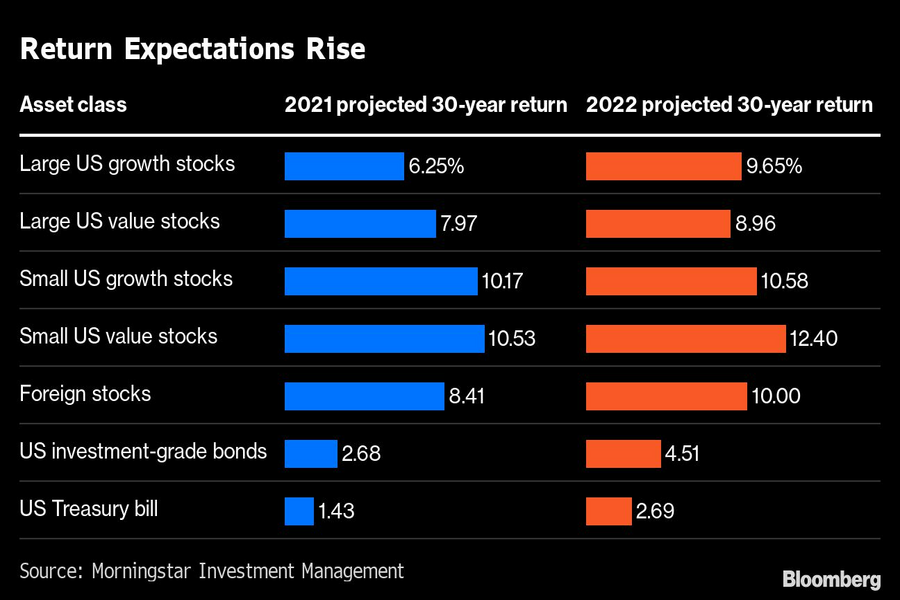

Things are looking up for people who are close to retirement, according to a Morningstar report published Monday.
With the outlook improving for stocks and bonds next year, the percentage of a nest egg that retirees can safely start withdrawing from savings has increased to 3.8%, up from 3.3% in 2021, the report said. That may seem strange with inflation still high, recession fears growing, and many portfolios down double-digits this year. But with the market battered, there are better odds that future asset returns will improve, feeding into the rationale for a higher withdrawal rate.
Morningstar Investment Management’s 30-year return forecast for U.S. large-cap growth stocks is now 9.65%, up from 6.25% in 2021. U.S. investment-grade bonds are now expected to return about 4.5%, up from less than 3% in 2021’s return assumptions. The long-term inflation forecast has also risen, to 2.84% from 2.21% in 2021.
“The biggest lift to our withdrawal rate came from higher fixed-income yields and cash yields,” said Christine Benz, Morningstar’s director of personal finance.

The safe withdrawal rate may be higher, but there’s a rub. Rising interest rates pummeled both stocks and bonds in 2022, so while the new rate is higher, the dollar amount taken from savings is likely to be lower.
The report uses the example of a retiree with an $800,000 portfolio split evenly between bonds and stocks. If that person used the 3.3% starting withdrawal rate recommended in 2021, she would have taken out $26,400 in her first year of retirement.
If the retiree waited until Oct. 1 to retire, however, her balance would have shrunk to $640,000. As a result, a starting 3.8% withdrawal would be $24,320.
Morningstar’s outlook indicates that boosting the percentage of stocks in a portfolio above 50% won't have much impact on a retiree’s starting safe withdrawal rate. This is a shift from recent years when equities have significantly outperformed bonds.
“Boosting equity allocations doesn’t get you a whole lot other than more volatility,” said Benz. In fact, the equity allocation could drop to 30% and the retiree could still spend the same amount, she said.
A longstanding personal finance rule of thumb set the starting percentage of assets a retiree could safely take from a portfolio at 4%. In subsequent years, that amount would be adjusted for inflation.
In reality, spending in retirement doesn’t follow a straight line. Generally, spending is higher in earlier retirement years and drops as people move into their mid-70s and 80s, putting aside what can be high end-of-life costs.
Many financial advisers recommend using dynamic approaches that involve pulling more or less from savings depending on whether a portfolio had a good or bad year.
As well, most retirees don’t increase their spending in line with inflation, and dialing back cost-of-living adjustments can make a big difference.
“If you don’t take the full inflation adjustment each year, you can get a higher payday early on,” said Benz. When Morningstar looked at what a safe starting rate would be if a retiree took out one percentage point less than inflation, it boosted the starting rate to 4.3%.

Integrated Partners is adding a mother-son tandem to its network in Missouri as Kestra onboards a father-son advisor duo from UBS.

Futures indicate stocks will build on Tuesday's rally.

Cost of living still tops concerns about negative impacts on personal finances

Financial advisors remain vital allies even as DIY investing grows

A trade deal would mean significant cut in tariffs but 'it wont be zero'.
RIAs face rising regulatory pressure in 2025. Forward-looking firms are responding with embedded technology, not more paperwork.
As inheritances are set to reshape client portfolios and next-gen heirs demand digital-first experiences, firms are retooling their wealth tech stacks and succession models in real time.
